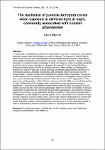The resilience of juvenile Acropora corals when exposed to artificial light at night, commonly associated with coastal urbanisation
| dc.contributor.author | Mullen, C. | |
| dc.date.accessioned | 2023-07-27T13:05:33Z | |
| dc.date.available | 2023-07-27T13:05:33Z | |
| dc.date.issued | 2023 | |
| dc.identifier.citation |
Mullen, C. (2023) 'The resilience of juvenile Acropora corals when exposed to artificial light at night, commonly associated with coastal urbanisation', The Plymouth Student Scientist, 16(1), pp. 25-48. | en_US |
| dc.identifier.uri | https://pearl.plymouth.ac.uk/handle/10026.1/21079 | |
| dc.description.abstract |
In recent years, artificial light pollution has expanded in area and concentration due to global population growth and technological advances in lighting. The impacts of artificial light at night (ALAN) are now well acknowledged within terrestrial biomes however, influences to surrounding coastal marine ecosystems are poorly recognised. Similarly, research has only just begun to reveal the extent of damage to coral reef systems, which have both substantial ecological and economic importance. However, the survival of important reef building Scleractinia within areas of ALAN is relatively unknown. Here a series of investigations underpin the extent of damage of short and long wavelength spectral street lighting to the reef building species, Acropora microclados and compared responses to coral of unlit coastal areas. A series of experiments quantified the pigmentation degradation throughout ALAN exposure and the response to recovery simulations to investigate if restoring natural solar cycles allowed pigmentation restoration. Results showed severe degradation of the green and red pigmentation within 49 days of exposure to both LED and metal halide lighting at night. While yellow ALAN caused more decline than shorter wavelength spectra in experiment 1, recovery investigations uncovered that within 28 days of exposure to ALAN, corals experienced 20% more green pigmentation decline in shorter wavelengths. Recovery experiments showed that recruitment of red and green pigmentation was reliant on previous spectral compositions during treatments and the restoration of the natural circadian rhythm. Investigations provide insight into species specific responses to real world scenarios of light pollution displayed around coastal waters. Additionally, research highlights that current reef recovery initiatives may be counterproductive in areas that are enduring the pressures of ALAN. Therefore, deeper understanding of the true impacts of ALAN is urgently needed in order to appropriately protect coral reef systems in proximity to developed coastlines. | en_US |
| dc.language.iso | en | en_US |
| dc.publisher | University of Plymouth | en_US |
| dc.rights | Attribution 3.0 United States | * |
| dc.rights.uri | http://creativecommons.org/licenses/by/3.0/us/ | * |
| dc.subject | Coastal urbanisation | en_US |
| dc.subject | artificial light | en_US |
| dc.subject | ALAN | en_US |
| dc.subject | pollution | en_US |
| dc.subject | coral reefs | en_US |
| dc.subject | bleaching | en_US |
| dc.subject | Acropora | en_US |
| dc.subject | zooxanthellae | en_US |
| dc.subject | coral resilience | en_US |
| dc.title | The resilience of juvenile Acropora corals when exposed to artificial light at night, commonly associated with coastal urbanisation | en_US |
| dc.type | Article | en_US |
| plymouth.issue | 1 | |
| plymouth.volume | 16 | |
| plymouth.journal | The Plymouth Student Scientist |



